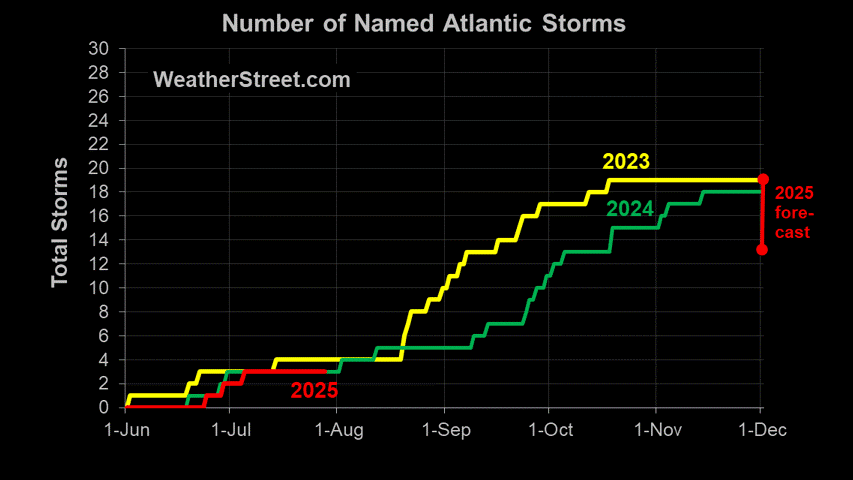N Atlantic: Storm Alert issued at 2 Sep, 2010 21:00 GMT (5:00 pm EDT)
Intense Hurricane EARL (AL07) is forecast to strike land to the following likelihood(s) at the given lead time(s):Red Alert Country(s) or Province(s)the United States
probability for CAT 1 or above is 80% in about 33 hours
probability for TS is 100% within 9 hours
Canada
probability for CAT 1 or above is 45% in about 45 hours
probability for TS is 85% in about 45 hours
Red Alert City(s) and Town(s)Siasconset (41.2 N, 70.2 W)
probability for CAT 1 or above is 80% in about 33 hours
probability for TS is 95% in about 33 hours
Hatteras (35.2 N, 75.6 W)
probability for CAT 1 or above is 75% within 9 hours
probability for TS is 100% within 9 hours
Chatham (41.7 N, 70.1 W)
probability for CAT 1 or above is 75% in about 33 hours
probability for TS is 95% in about 33 hours
Saint John (45.3 N, 66.1 W)
probability for CAT 1 or above is 35% in about 45 hours
probability for TS is 85% in about 45 hours
Yellow Alert City(s) and Town(s)Kitty Hawk (36.1 N, 75.7 W)
probability for CAT 1 or above is 20% in about 21 hours
probability for TS is 100% within 9 hours
Capeville (37.2 N, 75.9 W)
probability for TS is 85% in about 21 hours
Montauk (41.0 N, 72.2 W)
probability for CAT 1 or above is 20% in about 33 hours
probability for TS is 85% in about 33 hours
Charlottetown (46.2 N, 63.1 W)
probability for CAT 1 or above is 10% in about 45 hours
probability for TS is 85% in about 45 hours
Halifax (44.6 N, 63.6 W)
probability for TS is 85% in about 45 hours
Norfolk (36.9 N, 76.2 W)
probability for TS is 80% in about 21 hours
Providence (41.8 N, 71.4 W)
probability for CAT 1 or above is 25% in about 33 hours
probability for TS is 80% in about 33 hours
Fredericton (45.9 N, 66.7 W)
probability for CAT 1 or above is 20% in about 45 hours
probability for TS is 80% in about 45 hours
Atlantic City (39.0 N, 74.8 W)
probability for TS is 75% in about 21 hours
Boston (42.3 N, 71.0 W)
probability for CAT 1 or above is 20% in about 33 hours
probability for TS is 75% in about 33 hours
Belmar (40.1 N, 74.1 W)
probability for TS is 75% in about 33 hours
Bangor (44.5 N, 68.5 W)
probability for CAT 1 or above is 30% in about 45 hours
probability for TS is 75% in about 45 hours
Salisbury (38.3 N, 75.6 W)
probability for TS is 65% in about 21 hours
Portland (43.5 N, 70.4 W)
probability for CAT 1 or above is 15% in about 45 hours
probability for TS is 65% in about 45 hours
Hartford (41.5 N, 72.7 W)
probability for TS is 65% in about 33 hours
New York (40.7 N, 73.9 W)
probability for TS is 60% in about 33 hours
Augusta (44.3 N, 69.8 W)
probability for CAT 1 or above is 10% in about 45 hours
probability for TS is 55% in about 45 hours
Green Alert City(s) and Town(s)Wilmington (34.2 N, 77.9 W)
probability for TS is 50% within 9 hours
Concord (43.2 N, 71.5 W)
probability for TS is 45% in about 33 hours
Philadelphia (39.9 N, 75.2 W)
probability for TS is 45% in about 21 hours
Note that
Red Alert (Severe) is CAT 1 or above to between 31% and 100% probability.
Yellow Alert (Elevated) is CAT 1 or above to between 10% and 30% probability, or TS to above 50% probability.
Green Alert (Low) is TS to between 31% and 50% probability.
CAT 1 means Hurricane strength winds of at least 74 mph, 119 km/h or 64 knots 1-min sustained.
TS means Tropical Storm strength winds of at least 39 mph, 63 km/h or 34 knots 1-min sustained.
For graphical forecast information and further details please visit
http://www.tropicalstormrisk.com/This alert is provided by Tropical Storm Risk (TSR) which is sponsored by UCL, Aon Benfield, Royal & SunAlliance, Crawford & Company and Aon Benfield UCL Hazard Research Centre. TSR acknowledges the support of the UK Met Office.

















